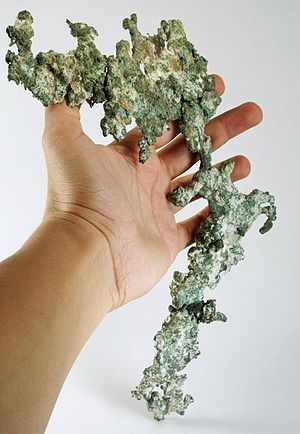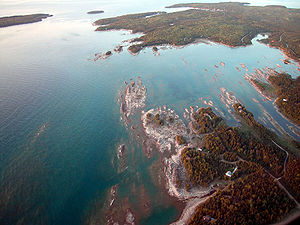 Image via WikipediaThe 2011 Michigan Technological University Fieldschool in Industrial
Image via WikipediaThe 2011 Michigan Technological University Fieldschool in IndustrialArchaeology will be back at the Cliff Mine and Clifton townsite for
the second year.
Join the Industrial Archaeologists from Michigan Technological
University, documenting an historic copper mine in the heart of the
Keweenaw Peninsula. The Keweenaw is famous as one of the few places on earth where humans found abundant formations of "native" copper, ranging in size from pebbles to record-breaking boulders of pure
metal. This will be the second season studying the ruins of the Cliff Mine and Clifton (1845-c.1870), the region's first profitable copper mine. The site sits atop and below the 200-foot greenstone bluff that runs along the spine of the Keweenaw Peninsula, about 30 miles northeast of Houghton, Michigan. We will be reconstructing the evolution of the industrial process using clues left by workers as they built, worked, and reworked the site's shafts, mill, engine house, kilns, stacks, shops, houses, and offices.
During the 2010 season, the research team completed a site survey,
gathering data using a Topcon Total Station and Digital Collector and
handheld Trimble GeoExplorer GPS units, supplemented with LiDAR
surveys of the ruined architecture. During the past year, researchers
built this data into a GIS framework that also included historic maps
and photographs, aerial photographs, and multispectral satellite
imagery. Discussion, images, and films of the research were posted on
the project blog:
http://cliffmine.wordpress.com
The 2011 field school participants will continue research in these
areas. Project members should anticipate learning and working in the
following areas:
1. Conducting excavations in the Stamp Mill Complex, investigating
work areas and processes in this well preserved and early example of a
mill. In addition, student researchers will use excavation and shovel
test probes to better define the extent, functions, and state of
preservation of other buildings throughout the mine and community,
including in areas near the Avery Shaft.
2. Research teams will ground-truth the CliffMAP GIS predictions of
landscape features and transportation infrastructure. They will base
testing on multispectral satellite images and historic aerial
photographs. Students will learn multiple documentation techniques,
such as digital and optical mapping, use of ground-based, aerial, and
satellite-based remote sensing in survey- including LiDAR and perhaps
ROV aerial photogrammetry, Underwater Acoustic and Sonar survey,
measured drawings, photography, and artifact analysis. The crews may
also have an opportunity to use a kite-based photography system.
3. Teams will continue to document the settlement of Clifton,
including more detailed mapping of the town and exploratory
excavations to assess research potential in this historic community.
The research focus includes attention to the food supply network, so
students can expect to learn archaeobotanical sampling strategies as
part of efforts to locate and understand the garden plots.
4. Michigan Tech's Industrial Archaeology research teams will be
collaborating with the the Nautical Archaeology Society's
International Field School at Northwestern Michigan College in
Traverse City, Michigan. The NAS Divers and students will join us to
begin exploratory acoustic and sonar mapping of the Cliff dock at
Eagle River and other maritime industrial features.
All participants in the Cliff Mine Archaeology Project become public
archaeologists, collaborating with community members and other guests
to the site. Along with fieldwork, there will be field trips,
lectures, and discussions devoted to the history and technology of
early copper mining in the Keweenaw and the communities and landscapes it produced. These public lectures are further supplemented by public days at the site where all research team members show site visitors around the Cliff, its community, and landscape, while discussing
connections between the story of copper and the Keweenaw's communities today.
The course is co-taught by Timothy Scarlett and Samuel Sweitz. Both
Drs. Scarlett and Sweitz are published anthropologists and
archaeologists with experience in North American hardrock mining
history and archaeology, in addition to the industrial and historical
archaeology of the United States, Mexico, and the Caribbean.
Course Details:
Students will live in Houghton. Michigan Tech will help guest students
to find accommodations in town for during the field school. Project
participants are encouraged to explore the Keweenaw during their time
off, and many will choose to bring outdoor recreation gear for
mountain biking, rock climbing, hiking, backpacking, and road biking,
and the many water sport opportunities provided by Lake Superior.
Students are also encouraged to attend the 2011 Annual Meeting of the
Society for Industrial Archaeology in Seattle, Washington. Both the
Keweenaw National Historical Park and Isle Royal National Park are a
short walk or bike ride from Houghton (To be clear, the NPS boat that
goes to IRNP is walking distance from Houghton, not the wilderness
island itself).
This is an equal opportunity course, and students with disabilities or
special needs should contact Dr. Scarlett to discuss accommodations
during the registration process.


